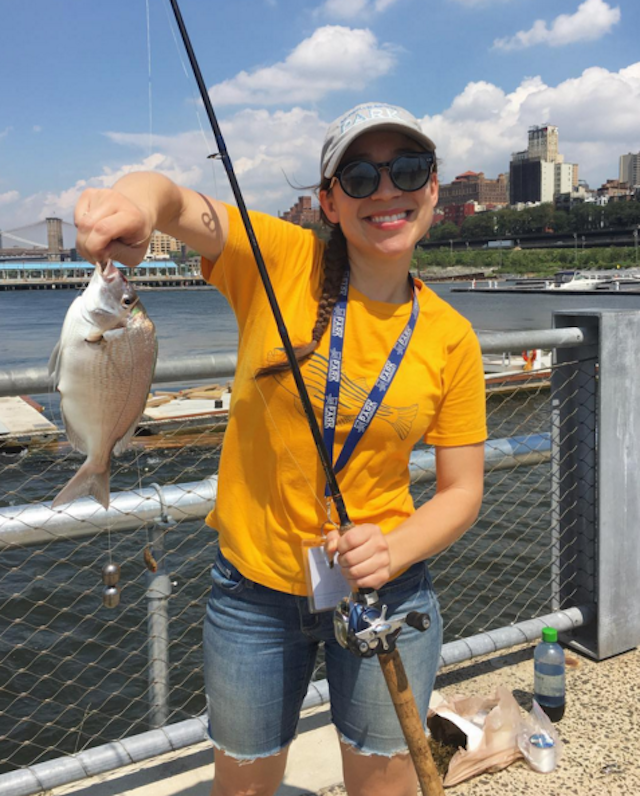
Isa Del Bello, the director of education at Brooklyn Bridge Park Conservancy, may have grown up in the desert, but she loves working on the water.
The Sante Fe, NM native taught elementary school in Albuquerque for three years, but she moved to New York in 2010 to pursue a graduate degree in developmental psych with the intent to do academic research, instead of teaching. While in grad school at the Teachers College of Columbia, she worked as a per diem teacher at Brooklyn Bridge Park and as an educator with Solar One’s Green Design Lab. That’s when she realized teaching city kids about nature was what she really wanted to do.
Whether lecturing about the history of East River oysters during a Wednesday night tour, wading out into the river with groups of volunteers to catch fish with a 20-foot seine net, or showing a class of elementary school kids what critters lie beneath the surface of the East River, Del Bello is passionate about educating kids and adults alike about the Brooklyn waterfront.
“A lot of city people look at the water and they don’t think there’s anything living in it, when in fact it’s a thriving ecosystem that is becoming stronger and stronger as time passes,” she says. The 33-year-old, who lives in Clinton Hill, joined Brooklyn Bridge Park full-time in 2013.
Isa Del Bello is today’s focus of Brooklyn Wild, our series where we talk to Brooklynites who have found a way to make their living by working in nature.
We spoke with Del Bello about jonesing for the ocean while living in the desert, her love of fishing and boating, and which upcoming Brooklyn Bridge Park events we should put on our calendars.
________
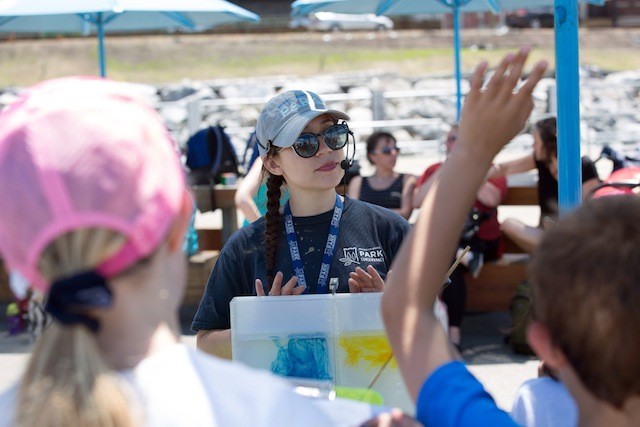
What drew you to environmental science, and what do you enjoy the most about teaching it?
I’ve always been interested in environmental science, in general, and having hands-on experience teaching in New York, really, it’s a very rewarding thing to do and it held my interest. And I did it as a non-city kid, so experiencing nature is not something that was ever new to me; I grew up around nature. I think the thing that most draws me to teaching kids about nature is that element of surprise. The bugs that they know are mosquitos and cockroaches. There’s this element of nature being scary and dangerous and dirty.
For one of the classes we teach, “Rove the Cove,” we go down to the water’s edge and pull up biotic and abiotic samples—three living things, three non living things. Initially you have these kids that are concerned with their shoes being dirty, cuz there’s algae and stuff, but by the end of the class they’ve forgotten about that and you kinda have to drag them away from the shoreline because they’re so enthralled by what they’ve discovered — algae and mussels, and the big find is Asian shore crabs, which is very surprising and fascinating to them.
________
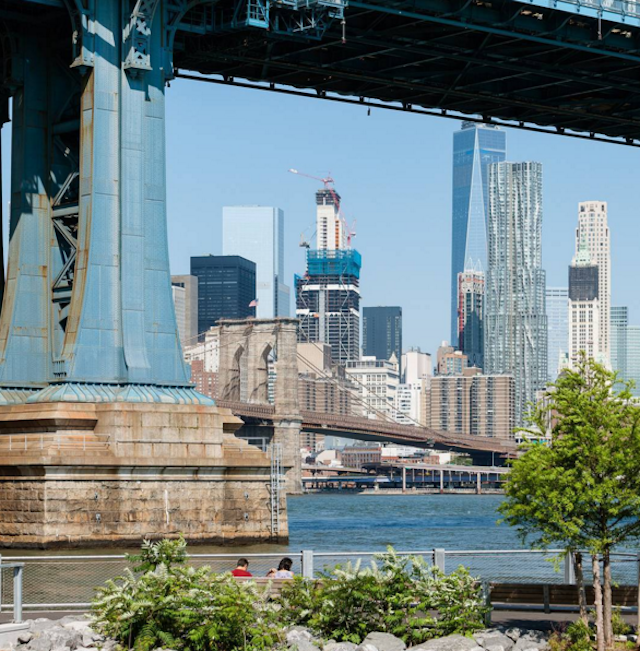
You grew up in the desert and now you work in a waterfront park. How did that happen?
What’s funny is when I was younger, I really wanted to become a marine biologist, but because I lived in the desert that sort of went by the wayside, but now it actually did come full circle! And as a kid I was always interested in nature, I would catch bugs and create habitats for them, but I think that there is something really special about the water, in general.
Especially in New York, you have these bodies of water — you’re surrounded by water — and it’s really easy to forget there are living things in there, especially with the history of the waterfront and how polluted it was, and it is still moderately polluted, but there is a general concept that the water’s dirty. It’s a special thing to be able to discover all the things that are out there (in the water) and to teach about it and to change people’s conception about it.
________
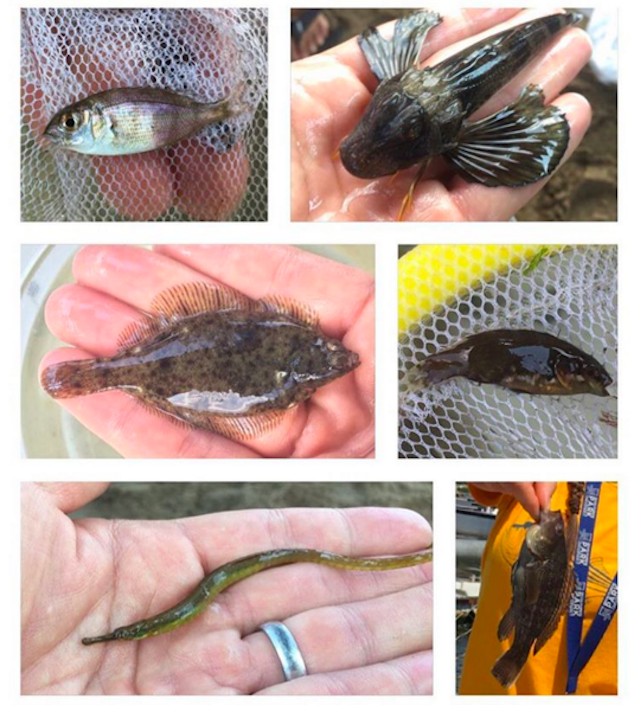
What does a typical day at your job involve?
It really varies. I can give you an awesome day that just happened! So Saturday we had the Hudson River Fish Count, and what that entails is basically spending the morning with a team of people, some educators and volunteers, and we went seining — it’s a type of net, and you fish with it. We take the four-feet-high, 20-foot-long nets with two poles on each end and we put on chest waders and walk out into the East River as far as we can go and see what we catch.
We have containers with East River water and bubblers to keep the fish aerated, and then at the end we collect all of the data, everything we caught, and conduct water quality tests, stuff like that, and assess what we should keep for our Environmental Education Center aquarium and what we should throw back. (It has a 250 gallon East River aquarium with fish we caught ourselves just outside. We do catch and release, but we do have a permit that allows us to keep some for educational display — but most will make it back in the water.)
So that was an awesome day, but sometimes it’s also just doing admin stuff, basic computer stuff, when I’m not teaching. We serve 10,000 students a year from all five boroughs. We teach estuary science, and with our programs, we want everything to be hands-on. We want students acting as scientists, collecting data. Usually a teacher will bring his or her kids one or three times a semester, depending on what they’re focused on. Our program goes from pre-K through high school, although we have worked with college and grad school.
Another thing I really try to do is visit other sites (Brooklyn Historical Society, River Project, Hudson River Park, New York Harbor School and even museums like Museum of the City New York and the Natural History Museum) and look at their best practices, to create a consortium or network of educators doing the same things so we can learn from each other and help each other.
________

What are some programs for adults that we should know about?
Through the end of September, we have our Wednesday night tour series. It tends to be ecology-based but there’s also some history stuff there. We have experts of the park, so maybe somebody from our horticulture or educational or operations staff, focusing on different aspects of BK Bridge park — those are called “park spotlights” — but we also do have guest experts come in, often historians who will talk about an historical aspect of the site.
Coming up, on Wednesday, Aug. 31, there’s Bugs of Pier 6, and then on Wednesday, Sept. 21, is a talk about the green roofs in the park. On Wed., Sept 28 there’s a fall foraging tour, led by naturalist Marie Viljoen.
I’m most excited about what will be our last public program (of the season) that really gets people down at the water’s edge and that’s a public seining on Sunday, Sept. 25, right under the Manhattan Bridge at the sandy beach there.
We try to have something different for every season—we do slow down a bit in the winter—but we’ll have winter talks and tours.
________
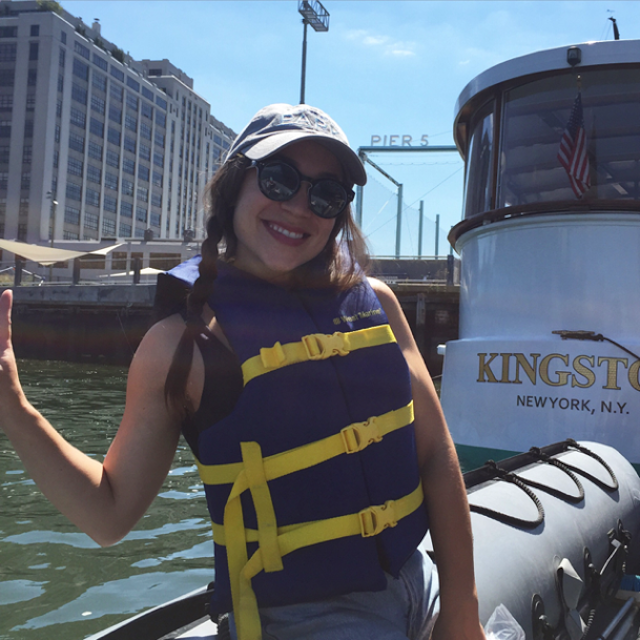
What’s your favorite thing to do at Brooklyn Bridge Park?
Fishing! There’s seining, as well as catch and release hook and line fishing at Pier 5’s fishing station.
Any opportunity to get on a boat, I will take it. Working within the waterfront community I have a lot of opportunities. If I know anybody with a boat, it’s pretty much guaranteed I will try to get them to take me and my staff out. At the park, we have free kayaking on Thursday evenings and Saturdays — get there early because there’s always a line — and also there’s Brooklyn Sail Club. I think on Saturdays and Sundays, before 11:30am there’s a free ferry to Governor’s Island from Pier 6. (Ed. note: after 11:30am on the weekends, a roundtrip adult ticket is $2).
For more info on upcoming BK Bridge Park events and activities, check out their events page.
Check out our previous installments of Brooklyn Wild: We’ve spoken with John Bingaman, the Fort Greene resident who takes city dogs on Doggie Day Trips upstate; Michelle Cashen, who quit her desk job to become the farm manager at Brooklyn Grange‘s Navy Yard location; and Dave Dicerbo, who ditched a corporate career to take New Yorkers hiking and backpacking with his company, Destination Backcountry Adventures.
One Response to
Leave a Reply




I loved this article and I felt your passion for what u teach and each day a new experience. I am so proud of you.
Keep up the good work